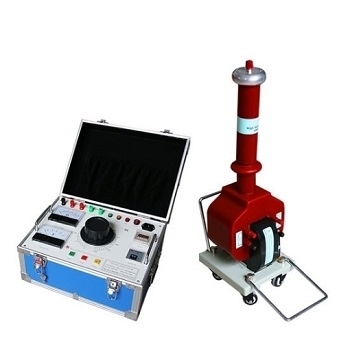Hipot tester is a test instrument widely used in industry, aerospace, power and other fields, which can test the insulation performance of electrical or electronic equipment. It can simulate the effect of a high voltage charge on the equipment and is used to determine whether the equipment meets the relevant safety standards to ensure its safety performance under normal conditions of use. sisco shop for you to introduce more details.
Operating Principle
The working principle of the Hipot tester is to apply a high voltage to the device to be tested through the test device and observe the change of its voltage resistance and leakage current. Specifically, it mainly includes the following two aspects:
- 1. High voltage source: The high voltage source is the core component of the withstand voltage tester, which pr
 ovides high voltage power supply and generates the high voltage charge required by the device to be tested. The voltage and current are set according to the requirements of the device being tested. High voltage is usually applied to the input, output and housing of the device to be tested to detect whether there is leakage.
ovides high voltage power supply and generates the high voltage charge required by the device to be tested. The voltage and current are set according to the requirements of the device being tested. High voltage is usually applied to the input, output and housing of the device to be tested to detect whether there is leakage. - 2. Test device: The test device consists of two main parts: a booster transformer and an ammeter.
A booster transformer is a special type of transformer used to convert an ordinary voltage into a high voltage. The principle is to transform the low voltage current into the required high voltage current through an acceptable transformer ratio adjustment. A booster transformer usually contains multiple independent, isolated outputs that can provide a high-voltage charge to multiple devices at the same time.
Ammeter is used to measure the current of equipment under high voltage conditions. It is generally combined with a booster transformer to measure the leakage current of the device being tested. Ammeters usually operate in two modes: impedance mode and current mode. In impedance mode, the internal circuit of the ammeter generates an electric field identical to that of the voltage tester, which is used to detect the impedance of the device being tested. In current mode, the ammeter can directly measure the leakage current of the device under test
Key Features and Uses
- 1. High Voltage Testing: Hipot testers can generate high voltages, often exceeding the expected operating voltage of the equipment being tested. This high voltage is applied between the conductive parts of the device and its insulation to assess the quality of the insulation.
- 2. Insulation Resistance: One of the primary purposes of Hipot testing is to measure the insulation resistance of the device under test. Good insulation should have a high resistance, so a lower current reading on the tester indicates better insulation quality.
- 3. Leakage Current Measurement: Hipot testers measure the leakage current that flows through the insulation when the high voltage is applied. Elevated leakage current may suggest potential insulation issues or defects.
- 4. Pass/Fail Criteria: The test results are compared to predefined pass/fail criteria. If the leakage current remains within acceptable limits, the device passes the test. If the current exceeds these limits, the device is considered to have failed the Hipot test.
- 5. Safety Testing: In addition to assessing insulation, Hipot testing can also verify the safety of electrical equipment. It helps identify potential electrical hazards and can uncover issues that might lead to electrical shock or fires.
- 6. Types of Hipot Tests: There are typically two types of Hipot tests:
Dielectric Withstand Test (AC Hipot): This test determines if the insulation can withstand high AC voltage levels for a specified duration.
Insulation Resistance Test (DC Hipot): This test measures the insulation resistance by applying a high DC voltage.

Application
- 1. Electronics Manufacturing:
Cable Assemblies: Hipot testing is used to verify the insulation of cable assemblies to ensure they meet safety and quality standards.
Printed Circuit Boards (PCBs): PCBs and their components are tested to ensure that there are no electrical leakage paths or insulation breakdowns. - 2. Medical Devices:
Hipot testing is crucial for medical equipment to ensure patient safety and the integrity of the devices. Equipment such as medical grade power supplies, patient monitoring systems, and diagnostic devices undergo Hipot testing. - 3. Aerospace and Avionics:
Components and wiring in aircraft systems are subject to Hipot testing to guarantee reliable operation in demanding and safety-critical environments. - 4. Power Distribution:
Electrical power distribution systems, such as high-voltage cables and transformers, are tested to verify their insulation and overall integrity. - 5. Consumer Electronics:
Products like power adapters, chargers, and appliances are tested to ensure that they are electrically safe for consumers to use. - 6. Automotive Industry:
Vehicle components, such as electrical harnesses, connectors, and control modules, are subjected to Hipot testing to meet safety and reliability requirements. - 7. HVAC and Industrial Equipment:
Heating, ventilation, air conditioning (HVAC) systems and various industrial equipment may undergo Hipot testing to ensure safe and reliable operation. - 8. Electrical Switchgear and Transformers:
High-voltage equipment like switchgear and transformers are tested to verify their insulation properties and ensure they can handle high voltages safely. - 9. Data Centers:
Electrical systems and components in data centers are tested to guarantee continuous and reliable operation, as data centers are critical for businesses and organizations. - 10. Lighting Systems:
Lighting fixtures and systems are tested to ensure safety and insulation quality, especially for commercial and industrial applications. - 11. Renewable Energy:
Solar inverters, wind turbine components, and other renewable energy equipment are subjected to Hipot testing to verify their electrical safety and reliability. - 12. Quality Control:
In various manufacturing industries, Hipot testing is used as part of quality control processes to catch potential defects early in the production process.
The key goal of Hipot testing in these applications is to identify insulation issues, such as cracks, weak points, or inadequate insulation, before they lead to electrical breakdowns, fires, or safety hazards. It plays a vital role in ensuring that electrical and electronic products and systems meet safety standards and reliability requirements. sisco offers a variety of high-voltage testers for you to choose from, such as 100 kV 10 kVA AC DC Hipot Tester,100 kV 5 kVA AC DC Automatic Hipot Tester, and so on. If you are interested, please click to buy!

